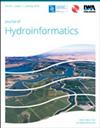下游障碍物对鹅卵石堰效率的影响:回归分析
IF 2.2
3区 工程技术
Q3 COMPUTER SCIENCE, INTERDISCIPLINARY APPLICATIONS
引用次数: 0
摘要
本研究深入探讨了下游阻塞角对明渠水流中鹅卵石堰排流系数(Cd)的影响,这是水利工程中准确预测流量的关键因素。通过一系列详细的实验室实验,运用一套回归分析方法来建立预测模型,仔细研究了各种阻塞角对 Cd 的影响。考虑到流速、水位和堰体几何形状等水力参数,分析结果更加丰富。尽管 Cd 在水力设计中的重要性已得到证实,但下游障碍物的细微影响却未得到足够重视,这凸显了一个关键的研究缺口。研究结果凸显了障碍物角度与 Cd 之间的密切联系,开发的回归模型显示出显著的预测能力。值得注意的是,这些模型表现出不同程度的准确性,其中随机森林回归模型的均方根误差 (RMSE) 特别低,仅为 0.005,显示出卓越的预测性能。相反,决策树和 XG BOOST 等传统模型的均方根误差值较高,达到 0.60,表明在这种情况下预测准确性较低。LASSO、贝叶斯岭和 OMP 回归因子的 RMSE 值为零,表明在研究的特定条件下预测结果完美。本文章由计算机程序翻译,如有差异,请以英文原文为准。
Impact of downstream obstructions on ogee weir efficiency: a regression analysis
This study delves into the impact of downstream obstruction angles on the discharge coefficient (Cd) over ogee weirs within open channel flows, a critical factor for accurate flow rate predictions in hydraulic engineering. Employing a series of detailed laboratory experiments the influence of various obstruction angles on Cd was scrutinized applying a suite of regression analysis to develop predictive models. The analysis was enriched by considering hydraulic parameters such as flow rate, water level, and weir geometry. Despite the established importance of Cd in hydraulic designs the nuanced effects of downstream obstructions have received limited attention highlighting a critical research gap. The findings highlight a strong correlation between obstruction angles and Cd, with developed regression models demonstrating notable predictive strength. Remarkably the models exhibited varying levels of accuracy, with the Random Forest regressor achieving an exceptionally low root mean square error (RMSE) of 0.005, indicating superior predictive performance. Conversely, traditional models like Decision tree and XG BOOST reflected higher RMSE values of 0.60, suggesting less predictive accuracy in this context. LASSO, Bayesian Ridge, and OMP regressors stood out with an RMSE of zero, denoting perfect predictions under the study's specific conditions.
求助全文
通过发布文献求助,成功后即可免费获取论文全文。
去求助
来源期刊

Journal of Hydroinformatics
工程技术-工程:土木
CiteScore
4.80
自引率
3.70%
发文量
59
审稿时长
3 months
期刊介绍:
Journal of Hydroinformatics is a peer-reviewed journal devoted to the application of information technology in the widest sense to problems of the aquatic environment. It promotes Hydroinformatics as a cross-disciplinary field of study, combining technological, human-sociological and more general environmental interests, including an ethical perspective.
 求助内容:
求助内容: 应助结果提醒方式:
应助结果提醒方式:


